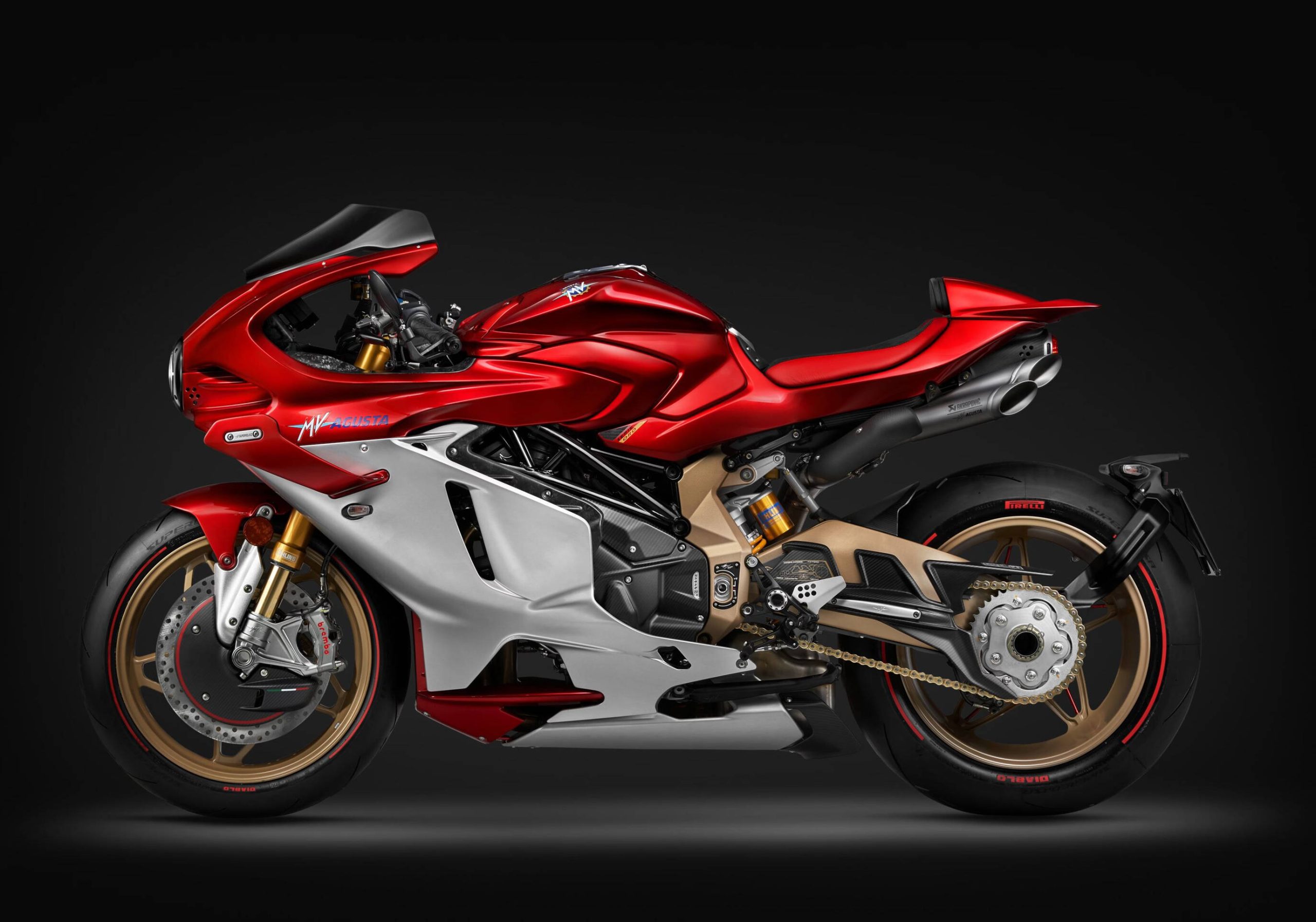
Manufacturers have discovered that there are plenty of wealthy individuals willing to spend the money necessary to acquire exotic limited edition motorcycles. In this vein, MV Agusta introduces the Superveloce 1000 Serie Oro.
Is this the ultimate MV Agusta in terms of beauty and performance? Perhaps, but only 500 units will be available, and many of those are already gone, apparently. U.S. pricing has not been announced, but we understand the U.K. price is £61,400 ($78,500 U.S. at current exchange rates).
Here is the press release from MV Agusta, followed by a video:
The Shape of Desire
The Superveloce 1000 Serie Oro represents the achievement of a clear objective for MV Agusta: to create an object that embodies the desires of every motorcyclist. The combination of stylistic research, attention to pure aesthetic pleasure, technological innovation, and breathtaking performance has allowed MV Agusta to achieve the goal set at the beginning of the project. Today, the market sees a motorcycle that undoubtedly occupies an oneiric dimension, literally embodying the shape of desire.
Design and Ergonomics
The new MV Agusta Superveloce 1000 Serie Oro is both a dream and a work of art. Produced in only 500 numbered units, it encapsulates MV Agusta’s unparalleled history in racing, the brand’s maniacal pursuit of aesthetic pleasure, and the continuous drive to push technological evolution further. The distinctive stylistic elements of the Superveloce 1000 Serie Oro, consistent with the Superveloce range, include round headlights that reference MV Agusta’s past, horizontally developed lines, and the aesthetic enhancement of using precious materials such as carbon fibre. The meticulous attention to every detail ensures harmony between forms, materials, and performance.
In the Superveloce 1000 Serie Oro, technology and style merge to create a true sculpture on two wheels. Designers and engineers have applied all their experience to achieve a combination of technique and beauty without compromise. One of the most characteristic elements, both technically and stylistically, is the presence of aerodynamic wings, marking a new paradigm in the design and development of new MV Agusta models. Beyond the crucial quest for the best aerodynamic penetration coefficient (Cx), the engineers also focused on optimising vertical load (Cz), with significant benefits for riding dynamics, ensuring incredible stability, a fundamental factor given the exceptional performance of the bike in terms of both top speed and acceleration.
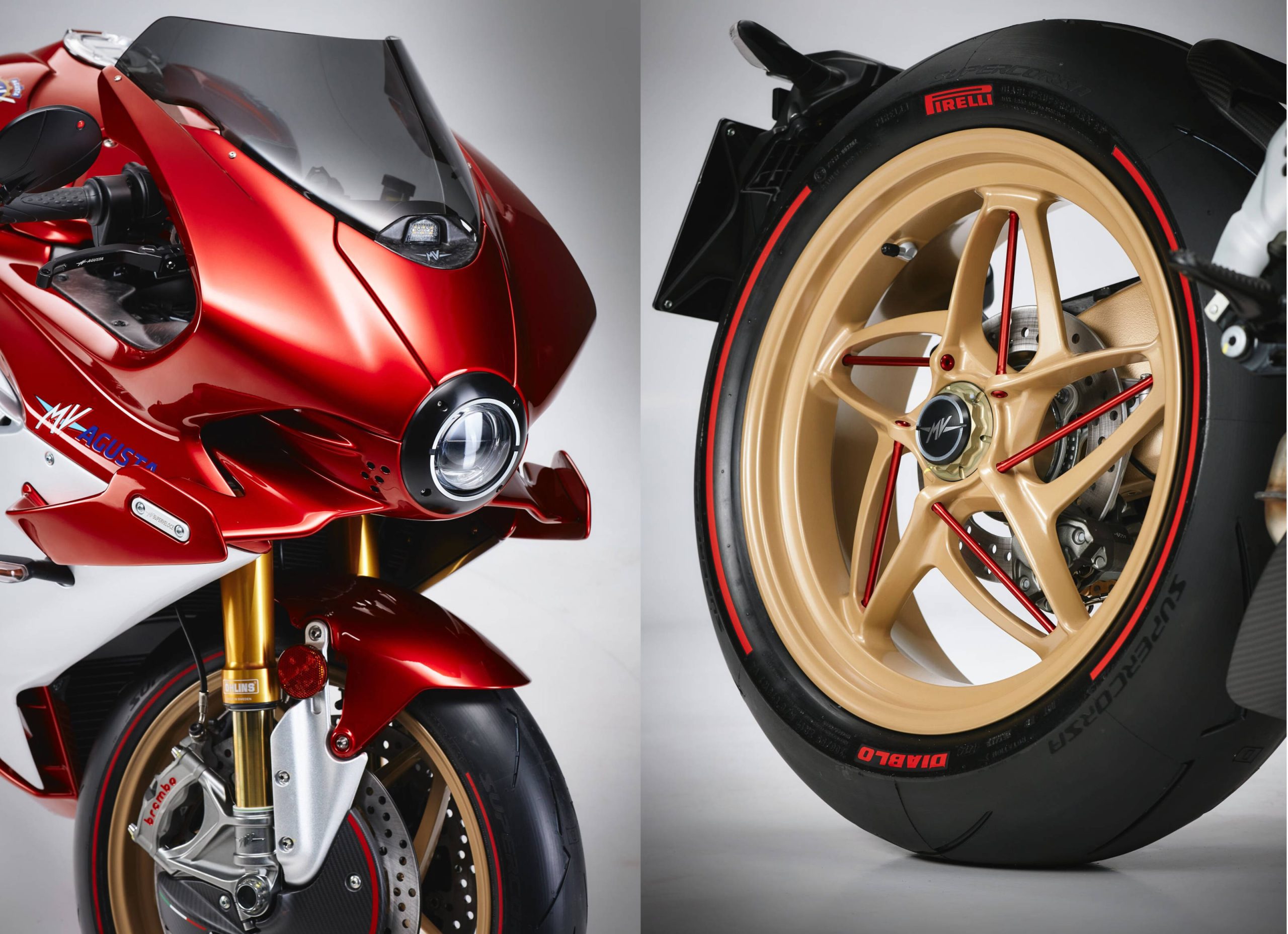
The aerodynamic wings on the fairing are not only elements with a strong visual impact but are perfectly integrated into the overall fluid dynamics management. In 1972, MV Agusta adopted similar aerodynamic solutions for its Grand Prix motorcycles, which the Superveloce 1000 Serie Oro draws original inspiration from. Extensive tests have shown that at high speeds, the bike offers absolute directional precision and stability, without sacrificing manoeuvrability and agility in different riding conditions. The analysis of aerodynamic flows, derived from aeronautics techniques, was a fundamental part of the development of the Superveloce 1000 Serie Oro, resulting in a final version of the bike that ensures optimal rider protection at high speeds, improved overall comfort, performance optimisation, perfect engine breathing, and hot air dissipation to ensure optimal usage conditions. The evolution of the design led to a reduction in the lower fairing’s extension and the development of a lateral aerodynamic opening to improve airflow.
The material chosen to give the Superveloce 1000 Serie Oro its aesthetic shape is carbon fibre, used in two different processes, forged and laminated, to add further stylistic refinement. There are 41 components made of carbon fibre, including the dashboard support, chain guard, full fairing, and other parts in the dedicated kit.
The iconic wheels are inspired by the stylised-star-shaped ones featured on the legendary MV Agusta F4 750 Serie Oro, reinterpreted with a stylistic exercise bridging past and future through a blend of cast and spoke wheels. The tribute to the F4 is also evident in the four-exit titanium exhaust developed by Akrapovic specifically for the Superveloce 1000 Serie Oro. This exhaust, with its characteristic “organ pipe” shape, is tuned to give the bike an iconic and distinctive sound, further enhanced by a carbon fibre heat shield.
The use of precious materials is evident in every detail of the Superveloce 1000 Serie Oro. The seat, for example, is designed to ensure the highest comfort combined with optimal ergonomics and made of leather and Alcantara – materials clearly belonging to the luxury world – and bearing the distinctive MV logo. A leather belt runs across the fuel tank’s entire length, starting from the laser-engraved plate at the base and continuing towards the “Superveloce 1000 Serie Oro” logo, under which the unit number is indicated. The rear wheel hub features the MV logo, with a design that mirrors the headlight, a unique detail in the world of two wheels. The use of titanium in the fasteners further enriches the Superveloce 1000 Serie Oro, which, as a tribute to MV Agusta’s history, features Ago Silver, Pearl Shock Red, and Gold Ciclistica colours.
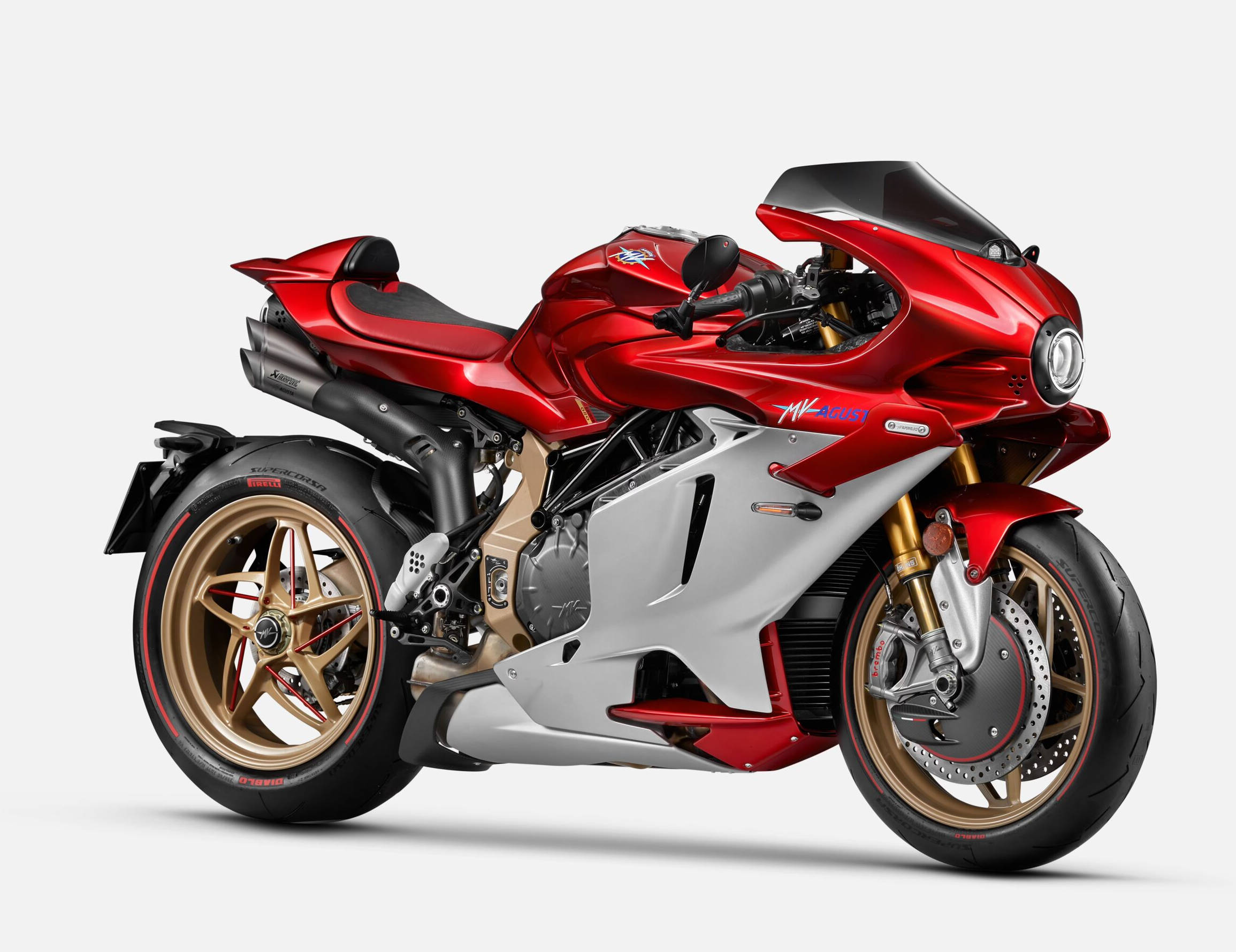
Engine and Electronics
The Superveloce 1000 Serie Oro boasts a four-cylinder inline engine capable of delivering 208 HP (153 kW) at 13,000 RPM and 116.5 Nm of torque at 11,000 RPM. Thanks to the use of 16 radial titanium valves, a distinctive feature of all MV Agusta four-cylinder engines, forged titanium connecting rods, and DLC-coated cams, the engine of the Superveloce 1000 Serie Oro can reach 14,000 RPM, and thanks to the countershaft, it maintains minimal vibration, resulting in a smooth driving experience even at performance limits.
The engine management is entrusted to the integrated MVICS 2.1 system (Motor & Vehicle Integrated Control System) with eight injectors: four lower and four upper, with increased flow rate. The throttle body is 50 mm in diameter.
The electronics have been meticulously calibrated specifically for the Superveloce 1000 Serie Oro. The disengageable traction control features eight levels of intervention: two for wet or slippery conditions (Rain), three for road use, and three for the track. The disengageable FLC (Front Lift Control) works based on data collected by the inertial platform and, instead of preventing wheelies, it optimises them by maintaining an optimal angle to make the most of the incredible acceleration. This rider aid works in conjunction with the Launch Control.
There are four Riding Modes: three preset (Rain, Sport, Race) and one customisable by the rider (Custom). In this mode, the rider can set parameters such as throttle sensitivity, engine torque, engine braking, engine response, limiter, and electronic suspension settings.
The MV EAS 4.0 (Electronically Assisted Shift Up&Down) electronic gearbox works both for upshifting and downshifting, even with an open throttle.
The Ride by Wire acceleration system, with a torque management algorithm, features a negative stroke on the throttle grip, allowing disengagement of the Cruise Control, which is also standard on the Superveloce 1000 Serie Oro.
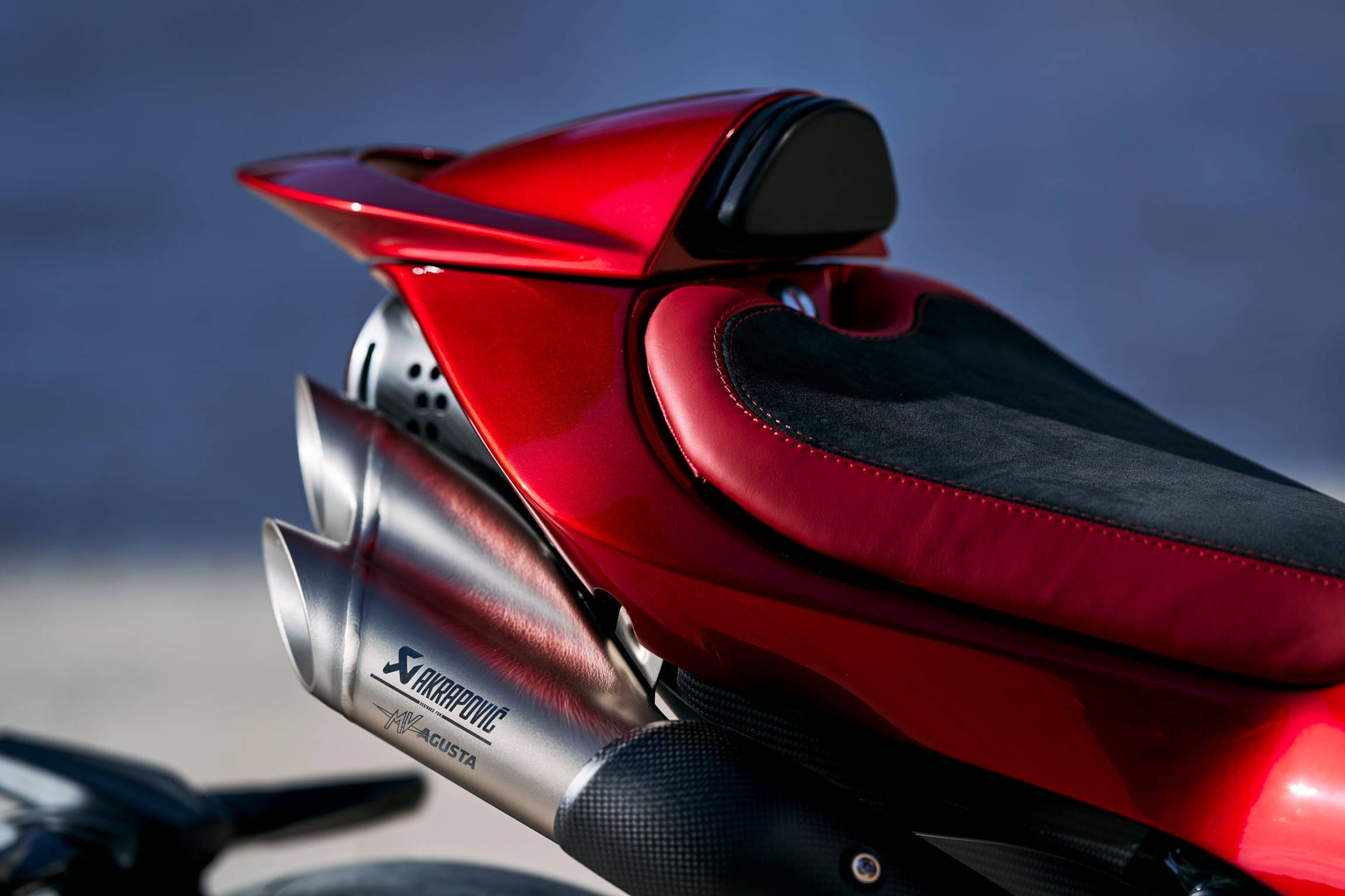
The Superveloce 1000 Serie Oro is equipped with an integrated GPS module that communicates directly with the MV Ride app, available for free across the entire MV Agusta range. Through this app, destinations can be entered, and corner-by-corner navigation viewed on the 5.5 inch TFT colour dashboard. Activating the Trip Record function initiates data acquisition. The experience begins before starting the engine and can be relived afterward by viewing the completed route, speed, gear used, lean angle, altitude, and travel times. The experience can be enriched by uploading the day’s route to share with other MV Ride App users. Among the various options of the MV Ride App, it is possible to customise the bike’s response through the Custom map, which can be renamed and even exchanged with other users. For example, one can create a “Tuscany” map to share later with other motorcyclists, fostering a community.
Completing the Superveloce 1000 Serie Oro’s electronic equipment is the satellite alarm with the Mobisat module, manageable via the Greenbox app, a service provided free to the customer for the first year.
Chassis
The trellis frame made of high-strength steel tubes is integrated with aluminium plates that hinge the single-sided swingarm, also made of aluminium alloy. The pin height is adjustable, with the adjustment range indicated on a specially designed plaque, also crafted with exceptional aesthetic care.
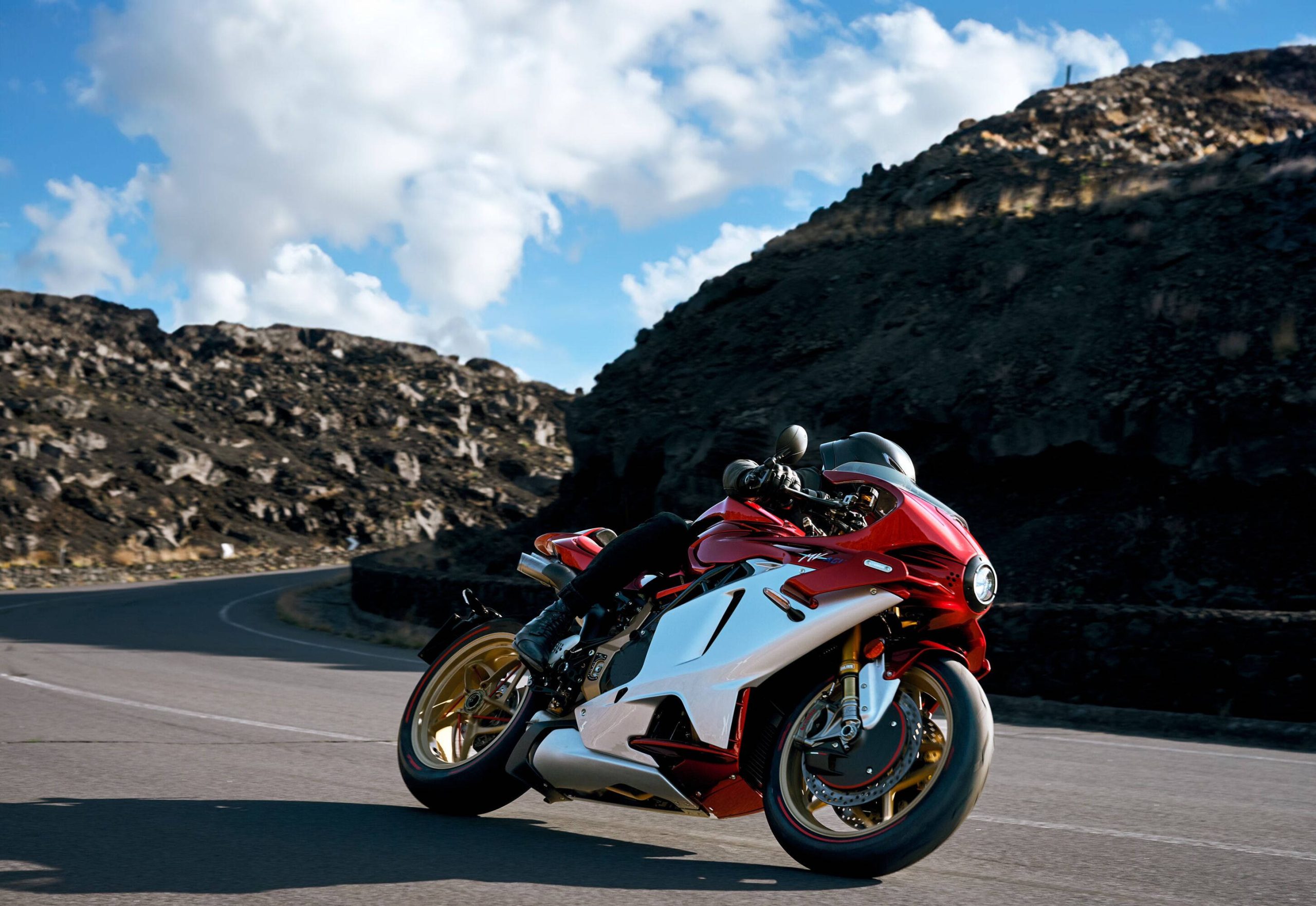
The Superveloce 1000 Serie Oro features an Öhlins electronic suspension system. At the front, it has 43mm diameter upside-down forks with a 120mm travel, treated with a TiN surface finish, and electronically adjustable for compression, rebound, and manual spring preload adjustment. To optimise stability, the suspension package includes an electronically adjustable Öhlins steering damper, capable of automatic intervention or manual setup to allow the rider to decide the best setup for their needs. At the rear, the suspension system is completed by an Öhlins mono-shock with a 36mm diameter and 120mm travel. The rear suspension is also electronically adjustable for preload, rebound and compression.
The combination between the incredible power unleashed by the four-cylinder engine, the stability at high speed granted by the aerodynamics and the outstanding agility of the Superveloce 1000 Serie Oro, is matched by a high-quality braking system. MV Agusta has relied on Brembo, opting for 320mm front discs with aluminium flanges and radial Stylema calipers with 30mm pistons, operated by a Brembo radial master cylinder. At the rear, there is a 220mm disc with a Brembo two-piston caliper with a 34mm diameter.
The power of this braking system is managed by the ABS system with two different levels of intervention. In Sport mode, indicated by an “S” on the dashboard, the ABS acts on both wheels with active cornering function and RLM (Rear wheel Lift-up Mitigation) active. The latter keeps the rear wheel on the ground during extreme braking, optimising the Brembo system’s power on both axles. In Race mode, indicated by an “R” on the dashboard, the ABS intervention is less invasive at the front, deactivated at the rear, and the cornering function is also deactivated, while the RLM system remains active but allows for a controlled lift of the rear wheel.
For the Superveloce 1000 Serie Oro, Pirelli has produced a dedicated version of the Diablo Supercorsa SP V4 with a characteristic red profile, adding refinement and exclusivity to the bike.
The pre-orders for the Superveloce 1000 Serie Oro were reserved exclusively to brand collectors. The few remaining units of the total 500 will be available through MV Agusta’s official dealer network. The lucky buyers who will be able to secure one will automatically be granted access to the same privileges and experiences reserved for collectors. The MV Agusta Superveloce 1000 Serie Oro UK price is £61,400.
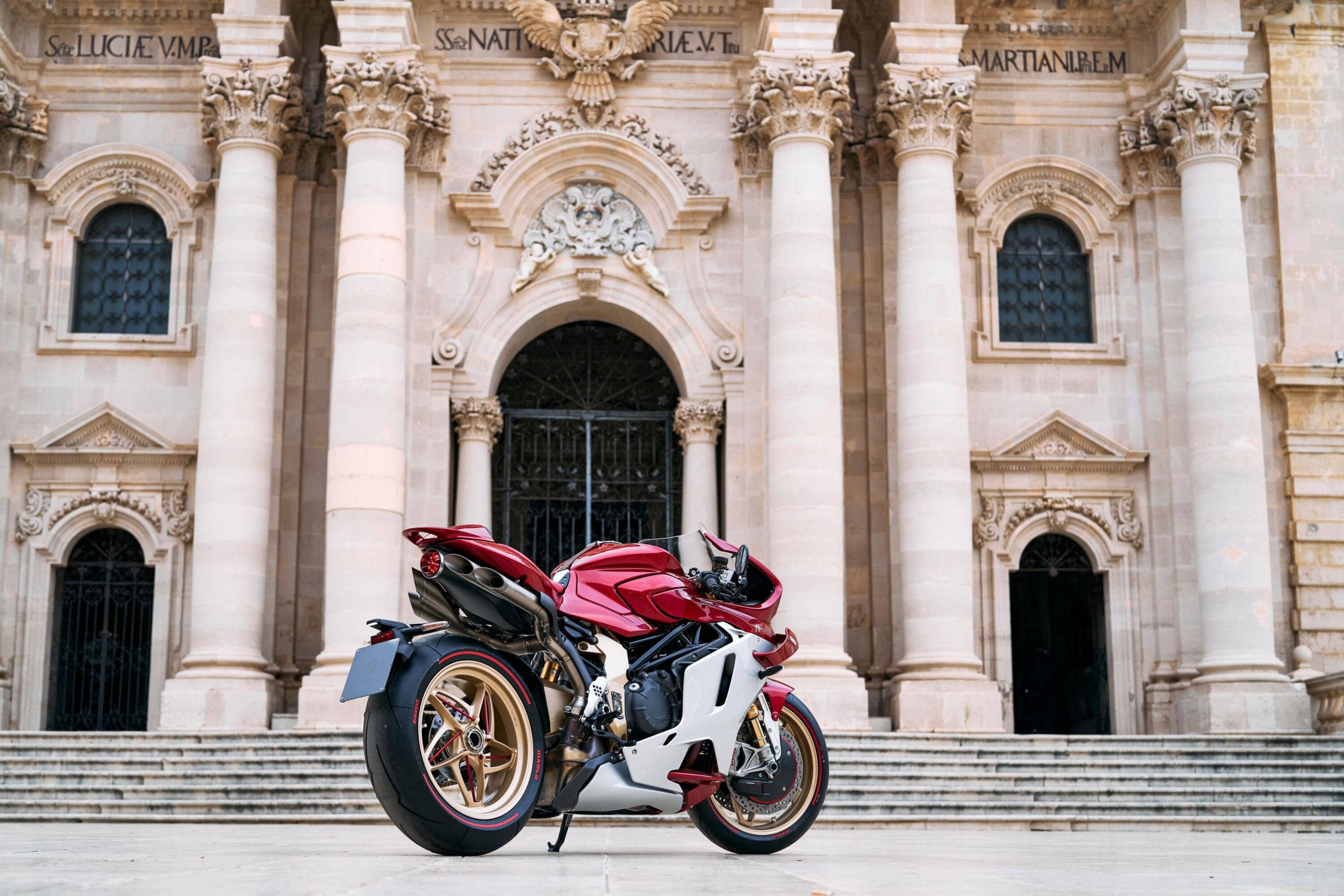
Dedicated Kit
As with every MV Agusta Limited Edition, the Superveloce 1000 Serie Oro customer receives a dedicated kit for their bike. This exclusive kit includes a certificate of authenticity and origin of the motorcycle, with the same numbering as the vehicle, and a dedicated motorcycle cover to protect this motorcycle artwork when it rests in the garage. Adding further value, the dedicated kit includes:
- Passenger seat in leather and Alcantara
- Passenger footpegs and supports
- Carbon passenger heel guards
- CNC-machined brake and clutch levers
- Height adjustment plates for the swingarm pin
To discover the all-new Superveloce 1000 Serie Oro, click https://www.mvagusta.com /product/superveloce/1000-serie-oro






I think it is a nice design in itself.
Not an MV of glorious years but cool.
When I began loving motorcycles as a twelve year old, my friends and I wanted a bike created that embodied the desire of every motorcyclist. Gary said attention to pure aesthetic pleasure, technological innovation and breathtaking performance was the most important thing for him. Terry thought a motorcycle that occupies an oneiric dimension came first. I just wanted a bike that could ride two middle schoolers without strain was the important thing. MV finally has created a bike that all three of us can agree on. Well done!
When I started riding, back in 91 at age 18, I wanted something small and fun. I got a 1970 Yamaha 90cc twin 2-stroke that I easily got running and it was a blast, took me everywhere (top speed of 75mph!). My friend also picked up an old Honda S90 and I also loved that thing. We would race around everywhere, even go on long camping trips. There’s nothing like that available today
Wonderful times man. Tim rode a Yamaha Twin Jet 100. The S90 is one of my favorite bikes ever; it’s still beautiful to look at. Ted got a scrambler version. El Paso, Texas is where it all happened for us. Don’t get me started on that big desert we played in. To me the way you started riding is perfect.
There’s a bunch of stuff like that, it’s just not 2 stroke anymore. Any street legal trail bike, a Ninja 300 or even (especially?) a 250cc+ scooter will do all of that.
looks like they didn’t let whoever was in charge of the headlight see what the rest of the bike looked like.
Pointless conspicuous consumerism for the rich and shameless. If you own one of these, you deserve to be at the front of the line when we start mulching the rich.
Your class warfare ambitions aside, I think this is one HECK of a sexy motorcycle. Poster material, just like the Countach of the 80s and Farrah Fawcett. Both equally unattainable of course.
I would rather have the poster of this than the actual bike. It’s a matter of value & motorcycling savvy.
A socialist thinks no one should be allowed to have one of these. A capitalist thinks everyone should.
A socialist THINKS everyone should to have one of these. A capitalist TELLS you that everyone will have one of these, while making damn sure that only a selected few will actually get one, making everyone else pay for it.
There, fixed it for you!
I like the concept, but it’s over designed, in some way reminds me the sport shoes of today, a lot of lines, folds and layer over layer over layer, no more logical and clean designs. It happens in almost every current motorcycle, it’s no wonder that the fans of ’90 bikes is every day growing.
In the nineties they would name the designer. The 2000s was the ugly headlight contest period. Since that time the industry really seems to be struggling to either find a designer that they are willing to name or not trusting the design to any one person. I think that it’s important to have one person design the whole bike. My problem with the bike above is that the design seems to be the work of at least three people.
I don’t know who designs the motorcycles today, but it seems that is pretty much the same person or an AI that makes all bikes look like insects (maybe those that they want us to eat ?). The worst are the naked bikes, but the faired ones aren’t much favored either, too much angles, too minimalists and many times is hard to believe that they are effective in a wind tunnel…
This is designed by “Italian Technology” & Team Kiska in Austria. (Designed by Corporate Committee)
Sport shoes of today!! You nailed it. I only buy adidas classics. New acquisitions are Superstar, Stan Smith, and the “Starsky” SL14. MUCH cheaper than an MV.
I don’t understand why some comments needs “moderation” and others don’t…
What I wanted to say is:
A-d-i-d-a-s is slow at bringing it back the classic designs, but they don’t last much and are replaced by new classics, that could disappear suddenly from the market. When I was a kid there was a little number of models that anyone could identify and remember, now are hundreds and always changing…
I’m in a constant struggle in my country, 95% of the sport shoes appears made for clowns, from the colors to the shapes, I really don’t understand how people accept to wear those things…
I guess I’m just old. I am one of the guys that bought one of the first 916s to show up in my area. I just can’t find anything to like on this bike. It’s so ill proportioned. The gas tank is too busy. The wings will always and forever look ridiculous.
I read an article recently about a women’s hand bag that you can buy for $11,500 and sell for $23,000. The stunning thing about the bag is that it would have to improve a great deal to become ugly.
Is this a new trend in conspicuous consumerism? If you are going up into people’s grill with some expensive kit. What fun is it to do so with something that is beautiful? No sir. If you spend extra, it must now be obnoxious. It’s like the otherwise beautiful women now days plastering on huge Groucho Marx eye brows. Um, yeah. You run with that sister.
Ironically, it was learned from the Prius. If you wanted to sell something that was a “signal” for something, like environmentalism for the Prius, it needed to be conspicuous for people to notice. At the same time, the Civic Hybrid was a sales flop because it looked just like the regular Civic – nothing to signal to everyone your virtues. In order to sell this bike for lots of money, it needed to be super flashy and look completely impractical to help signal that the owners have money to burn. It’s no longer about the bike and what it is, it’s about the owner and how special he is.
The Prius moment was weird. Though I did get one as a rental during a snowstorm after I had been away from Minnesota for three years. I wasn’t happy…at all.
But, credit where it’s due, the darn thing actually worked quite well in about six inches of heavy wet. Real nasty stuff. Go figure. To say my flabbers were gasted would be an understatement.
On electric cars, well, I have driven a Model T Ford. Measured by time available for development, they really aren’t doing to badly. Not my thing perhaps. But if I ever needed a dedicated grocery/mountain bike getter I would be looking for a minitruck sort of configuration. Which would make sense. So of course it will never happen until I am more interested in pushing up the daisies over my grave than cruising to some cool trail.
Lots of visuals to be pleased about and many to ignore. But you probably don’t want to own a cookie cutter if this is in your eye. Unusual but refined and 208 ponies makes for entertainment galore. Gentle reminders of motorcycles gone by, rear wheel Honda RC30, tail section 1979-80 Honda CBX, red paint from Mazda. But somehow it all works like pineapple on pizza, either you like it or you don’t.
I really like everything about the way this bike looks, except for one thing: the front headlight. Looks too small, too basic, and too, um, round ? Something’s off.